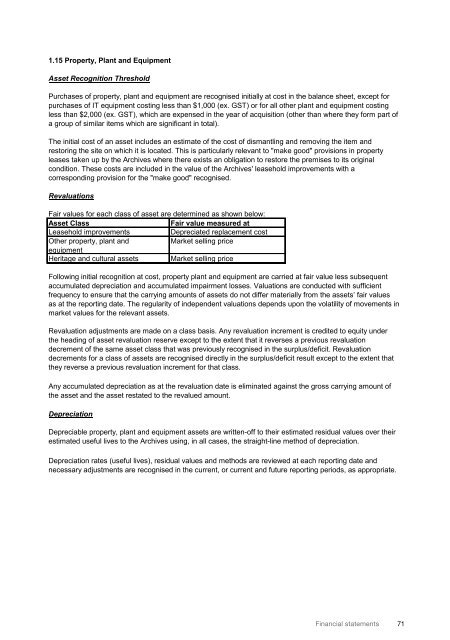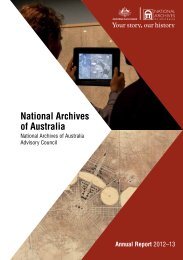National Archives of Australia - Annual reports
National Archives of Australia - Annual reports
National Archives of Australia - Annual reports
You also want an ePaper? Increase the reach of your titles
YUMPU automatically turns print PDFs into web optimized ePapers that Google loves.
1.15 Property, Plant and EquipmentAsset Recognition ThresholdPurchases <strong>of</strong> property, plant and equipment are recognised initially at cost in the balance sheet, except forpurchases <strong>of</strong> IT equipment costing less than $1,000 (ex. GST) or for all other plant and equipment costingless than $2,000 (ex. GST), which are expensed in the year <strong>of</strong> acquisition (other than where they form part <strong>of</strong>a group <strong>of</strong> similar items which are significant in total).The initial cost <strong>of</strong> an asset includes an estimate <strong>of</strong> the cost <strong>of</strong> dismantling and removing the item andrestoring the site on which it is located. This is particularly relevant to "make good" provisions in propertyleases taken up by the <strong>Archives</strong> where there exists an obligation to restore the premises to its originalcondition. These costs are included in the value <strong>of</strong> the <strong>Archives</strong>' leasehold improvements with acorresponding provision for the "make good" recognised.RevaluationsFair values for each class <strong>of</strong> asset are determined as shown below:Asset ClassFair value measured atLeasehold improvementsDepreciated replacement costOther property, plant andMarket selling priceequipmentHeritage and cultural assets Market selling priceFollowing initial recognition at cost, property plant and equipment are carried at fair value less subsequentaccumulated depreciation and accumulated impairment losses. Valuations are conducted with sufficientfrequency to ensure that the carrying amounts <strong>of</strong> assets do not differ materially from the assets’ fair valuesas at the reporting date. The regularity <strong>of</strong> independent valuations depends upon the volatility <strong>of</strong> movements inmarket values for the relevant assets.Revaluation adjustments are made on a class basis. Any revaluation increment is credited to equity underthe heading <strong>of</strong> asset revaluation reserve except to the extent that it reverses a previous revaluationdecrement <strong>of</strong> the same asset class that was previously recognised in the surplus/deficit. Revaluationdecrements for a class <strong>of</strong> assets are recognised directly in the surplus/deficit result except to the extent thatthey reverse a previous revaluation increment for that class.Any accumulated depreciation as at the revaluation date is eliminated against the gross carrying amount <strong>of</strong>the asset and the asset restated to the revalued amount.DepreciationDepreciable property, plant and equipment assets are written-<strong>of</strong>f to their estimated residual values over theirestimated useful lives to the <strong>Archives</strong> using, in all cases, the straight-line method <strong>of</strong> depreciation.Depreciation rates (useful lives), residual values and methods are reviewed at each reporting date andnecessary adjustments are recognised in the current, or current and future reporting periods, as appropriate.Financial statements 71



